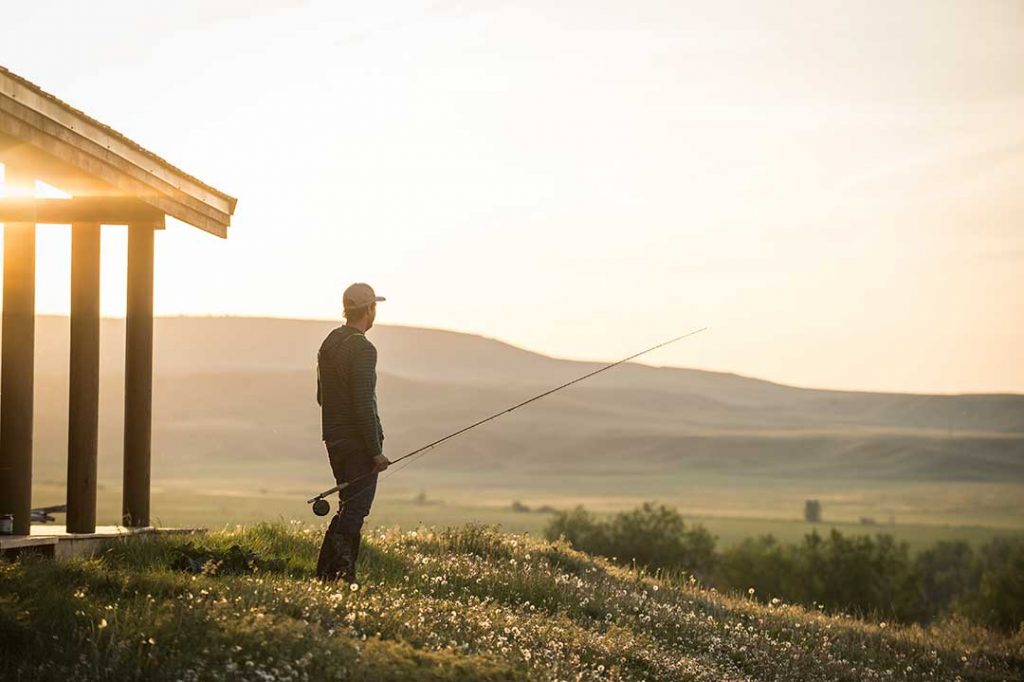
By Kirk Deeter
Fly fishing is basically about problem solving. Adapting to the environment around us. Anticipating what might happen next. That’s what we do. We revel in challenges.
While some in this industry are still certainly reeling from the effects of the COVID-19 pandemic, others are keeping their heads above water, and some are even making money hand over fist. For example, David Leinweber, owner of Angler’s Covey in Colorado Springs was recently on Fox News where he explained how his business (like many fly shops) went from bust to boom over the course of the summer.
That’s great, but David raises an interesting point when he wonders what next year might look like, and how many newbie anglers will actually stick around.
I also hear from many in this industry whether we want so many people to “stick around,” at least in some places.
There is no denying that fly fishing is experiencing a MOMENT. More people have found the water this summer (in the absence of youth sports leagues, and crowded malls, movie theaters, etc.) than ever before. And if you listen to public health experts, it’s going to take many months—even after the development of a safe and effective vaccine—for things to look anything like pre-pandemic “normal.” There’s every reason to assume next summer will look a lot like this one, at least on rivers and lakes.
In some regards, like families embracing the sport, the infusion of youth and diversity, people appreciating public lands and waters more than ever… that’s nothing short of wonderful.
In other regards, like the crowded boat ramps and daily raft and dory armadas choking certain rivers… the silly piles of rocks popping up in pristine trout streams (big time kudos to Fly Lords for literally putting the boot to “cairns”)… and the shortages of some products that retailers would sell like hotcakes if only they could get their hands on them… well, those are things we probably ought to talk about.
With that in mind, I’m going to throw out four topics that I think will factor strongly in the next several months, and invite you all to chime in as well.
Quality engagement. For years, “grow the sport” has been the mantra. If more people take a sip of fly fishing, more people will invest themselves in the sport, and become steady customers and stewards of resources. Well… that’s sorta true. If we actually take the time to teach fly fishing, we’ll end up with happier, more dedicated consumers. If we fail to do that, and just take them for boat rides, and/or send them out the door with a new rig but no clue how to actually use it, that might ring the cash register short term, but we risk creating a hole in the bucket of already dedicated anglers who get turned off by over-pressured waters. And also we risk the newbie getting bored, frustrated, and ultimately doing little else for fly fishing than taking up space. Teaching is the key. Fly shops and guides are key gatekeepers in this regard. If you’re looking for a reason how the dealer stays relevant in an era when manufacturers also sell direct you just found it.
Ethics. I’ve been low-holed more times this summer than I have in the past decade. I’ve seen more people leave a raft or drift boat in the middle of a busy boat ramp for a half hour or more, more often this year than any other. I’ve seen a lot of hook-scarred and floating trout. I haven’t seen many shouting matches, but I have heard from others who have. You can’t be upset with some of these people, because many of them simply do not know any better. They’re new. They’re enthusiastic. They’ve found God’s country, and like everyone else, they’re a little “off their game” to begin with because of all the weirdness in the world. Manufacturers and retailers need to work together to politely, gently instill the ethic as part of the teaching process. Lead by example.
Fly tying. One of the things I’ve noticed is that many of the people who “discovered” fly fishing this summer didn’t really discover it for the first time, rather, they reconnected to the sport they knew a bit about, but were too busy to engage in… until now. It was “teed up” perfectly to engage young families in fly fishing… right up until those families had to figure out how and where their kids would be educated this year. This is a bit of an aside, I admit, but I think fly tying is going to experience this winter what fly fishing did this summer, meaning people who used to do it are going to come back to it. I’d be stocking up on fly-tying materials, and figuring out e-commerce channels and ways to teach would-be tiers like my business depended on it in the near future, because for some of you, it will.
Public access and conservation. With so many people getting out to fish, hunt, hike, camp, and such in recent months, it’s become obvious that we need more and better public land and water access than ever before. In the very least, the current situation should put a temporary halt to the dopey assertion that the federal government should divest of public lands and waters. If there are going to be more anglers, we need more fish. Not more stocked fish. More fish that run naturally in the seas, rivers, and lakes. We need cleaner water, and more miles and acre-feet of it. And we need it starting now. You can’t play golf if nobody cuts the fairways and rolls the greens. Same for fly fishing; if there’s no place to play, we risk shrinking under the weight of our own enthusiasm.
With strategic thinking and collaboration, I think we can take this “moment,” make the good things stick, and eventually put the bad in the past. There’s no better community of professional problem solvers to be found anywhere in the world.
Stay safe, stay smart, stay healthy… Angling Trade is here to help and we appreciate your collaboration and input. Always.




9 Comments
i usually don’t comment online but his article is great, Kirk Deeter nailed it.
Totally agree on fly tying prediction. I have tied more this spring and summer than ever, and plan to power through winter months.
Great article. I loved Kirk’s golf analogy, and would add this to his comment “You can’t play golf if nobody cuts the fairways and rolls the greens” …AND YOU DON’T EAT THE BALLS.
Too, I appreciate the article pointing out the value of teaching and the role the professional shop plays in growing the sport. “If you’re looking for a reason how the dealer stays relevant in an era when manufacturers also sell direct you just found it.”
Absolutely. And if, as a dealer you needed another reminder that your biggest competitor are those manufacturers who are cannibalizing retail sales, you just got it.
I’m tutoring a new to fly fishing 34 year old man. He is enthusiastic and increasingly engaged. He caught a small fish this past weekend but I immediately took note, he had no idea how to unhook the poor thing. So, I said leave it in the water and walk toward me as I wade down to you and I illustrated how to gently hold, no finger near a gill, no squeez and hold the fishes mandibles together so you can back out, not twist out the hook causing no damage. Then this led to a calm dialog about our responsibility to our fish and their habitat as being primary to the ethical enjoyment of this passionate sport. His casting is improving and I think his insight is is too. I’ll give him another decade.
Thanks for the insight, Kirk. It’s nice to see that some fly shops are smartly pivoting with the environment when they need to…those that don’t, won’t be around much longer.
We market solitude, wilderness, connectivity, community and adventure.
If we fail to aggressively invest in those fundamental values…. and just push “more”.
Well…
Pretty soon it’s just not possible to crop out all those big houses, boats, anglers, hammered fish and foot prints from our pretty marketing shots.
Looking forward to seeing the positive impacts when everyone who had a “banner” year starts giving back to maintain the values that help drive the market!
Since the golfing analogy was made in Kirk’s post, I think it’s worth mentioning that I replaced most of the time I would normally spend on the water with time on the municipal golf courses. Even though golf is a pay to play activity, a twilight round at my local muni is $12 (2 flies and a leader) and by making a tee time, I knew that during that timeslot, my group would be able to show up, pay our greens fees, and be able to begin play at our scheduled time without worrying that another group would show up in the middle of the fairway, start playing in front of us, and leave their empty beer cans on the green when they were done. If someone working at the course observed someone doing this, the offenders would be reprimanded or thrown off the course. And when tee times weren’t available, you could still go to the driving range and hit balls for an hour, which for me, is much more satisfying than practicing casting in a field. With enough money, you can always build a new golf course if one area gets too crowded, but unfortunately, we can’t build new rivers to handle the increasing numbers of new anglers.
Although there is no infrastructure for enforcing angling numbers on public water, we should think hard about how we can increase funding at the local level for license and poaching enforcement while also engaging newcomers in conservation initiatives, and teaching how our collective behavior effects our local fisheries. Despite the huge swell of new angler traffic on our rivers and the major uptick in gear purchases, we have seen almost no growth in membership in our local TU chapter this year.
Perhaps shops, online retailers, and equipment manufacturers could consider offering small discounts on equipment to TU/BTT/Sierra Club/1% FTP/ETC members like AAA/AARP members receive at hotels, movie theaters, etc to encourage people to join an organization that promotes the sustainability of our sport. Not only will they be able to afford nicer gear at a small discount where the manufacturer/retailer still makes a profit, but maybe they’ll stick with fly fishing because now they feel like they’re part of a group of like-minded people instead of just being a number on a growth chart for rod sales in 2020.
Kirk,
You nailed it buddy in every detail and aspect of fly fishing’s future for those who have invested their life and personal money to own and operate fly shops or guide businesses and also teach and assist the fishing public, now and into the future!
I hope manufacturer’s read this article and understand they have ‘poached’ customers away from solid retailers who invest in inventory and expect to be profitable. Manufacturers are now being run by investment groups that could care less whether an existing fly shop remains viable or whether a long-term relationship has any value.
Their philosophy is that there will always someone willing to invest $200,000 or more to start another fly shop to replace – or compete – with the one that has lost profitability because their customer can now can buy direct from the likes of Simms, RL Winston, Abel, Ross, Far Bank, Fishpond and the rest of the suppliers. Sad.
I hope the companies wanting dealers to make pre-season orders and invest in their products wake up and understand there will always be a limited number of individuals wanting to invest in the sport of fly fishing for the long term. Less than 3% of the population is their audience and has been for decades. With those percentages, opening new fly shops and competing with such makes no sense except to the manufacturer. They win on both sides now.
I look forward to more wisdom from Kirk.
Kirk,
I think you summed up things pretty well, but of course I have to chime in and add the obviously, the right in front of you nose, the elephant in the room, thing…
If the flyfishing industry is truly going to grow, we have to grow past “The River Runs Through It” dilemma because we can’t make more rivers. As we have discussed many times over a few too many beers, for flyfishing to truly grow we have to grow in Stillwater and Backcountry angling.
Stillwater use to be cool. Twenty years ago, every reel we sold we added a spare spool with a sink-tip line. I don’t even stock reel spools anymore. Stillwater flyfishing has become an old man’s game and mysteries beneath the surface are fading and often irrelevant to the current flyfishing connoisseur. Yet the hottest category the past ten years in conventional fishing is kayak fishing. How many times do you see images of anglers flyfishing for trout from a kayak? Most trout fly shops these days don’t even stock float tubes. There just is little to no demand.
Backcountry angling is also greatly underdeveloped. Hike more than three miles into the forest along a stream and you will find yourself isolated and alone surrounded by awe… Hike a peak and you get to share it with 100 other people! If you are truly looking for that quiet moment on the stream you will have to pay for it either with cash or with miles.
As an industry we have to find a way to ignite these categories.